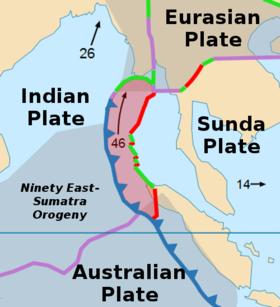Burma plate
| Burma Plate | |
|---|---|
 |
|
| Type | Minor |
| Approximate area | 1,100,000 km2 |
| Movement1 | north |
| Speed1 | 46 mm/year |
| Features | Andaman Sea |
| 1Relative to the African Plate | |
The Burma Plate is a minor tectonic plate or microplate located in Southeast Asia, sometimes considered a part of the larger Eurasian Plate. The Andaman Islands, Nicobar Islands, and northwestern Sumatra are located on the plate. This island arc separates the Andaman Sea from the main Indian Ocean to the west.
To its east lies the Sunda Plate, from which it is separated along a transform boundary, running in a rough north-south line through the Andaman Sea. This boundary between the Burma and Sunda plates is a marginal seafloor spreading centre, which has led to the opening up of the Andaman Sea (from a southerly direction) by "pushing out" the Andaman-Nicobar-Sumatra island arc from mainland Asia, a process which began in earnest approximately 4 million years ago.
To the west is the much larger India Plate, which is subducting beneath the eastern facet of the Burma Plate. This extensive subduction zone has formed the Sunda Trench.
In models of the reconstructed tectonic history of the area, the generally northwards movement of the Indo-Australian Plate resulted in its substantive collision with the Eurasian continent, which began during the Eocene epoch, approximately 50–55 million years ago (Ma). This collision with Asia began the orogenic uplift which has formed the Himalaya mountains, as well as the fracturing of the Indo-Australian plate into the modern Indian Plate, Australian Plate, and possibly Capricorn Plate.
...
Wikipedia
